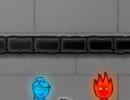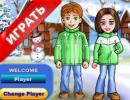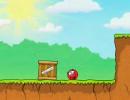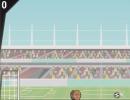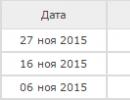Team work in kindergarten. Theoretical foundations of collective activities in application classes with children of senior preschool age. We work and create masterpieces in a friendly “team of like-minded people”
From the experience of working as a teacher kindergarten
Description: This material is intended for kindergarten teachers and parents.Participants: children preschool age.
Target:
provide children with the opportunity to embody images of the world around them in compositions and create conditions for creative interaction.
Tasks:
Educational:
learn to create collective works, demonstrate your artistic abilities in various types visual activities;
Educational:
develop Creative skills, fantasy, imagination;
Educational:
cultivate the ability to work together, build communication, develop the habit of mutual assistance.
One of the forms of conducting educational activities in kindergarten is collective work, the result of which is general paintings, panels, and compositions.
Collective works with children are created starting from early preschool age in drawing, modeling, appliqué, and design.
Creating common pictures, compositions where the images of all the children in the group are combined gives children great joy. Such pictures have a more significant result for children, they cause admiration, truly like in the poem by V. Mayakovsky: “What one cannot do, we will do together.”
In the process of performing collective work, the moral and aesthetic education of children is carried out, the following skills:
- agree on joint work and its content;
- work together, give in to each other, help, suggest, thus developing children’s communication abilities;
- plan your work, determine its sequence, content, composition, additions;
- rejoice at your own and your comrades’ successes in creating work.
The developmental potential of this form of work lies in the development in children of self-regulation and the ability to interact in a team.
I would like to note that among the targets at the completion stage preschool education The Federal State Educational Standard for Education states that “the child actively interacts with peers and adults... is able to negotiate, take into account the interests and feelings of others.”
Carrying out collective work, we create decorations for the holiday, create panels for leisure, for a child’s birthday, illustrate fairy tales, poems, etc.
I choose a variety of topics for collective works, but I am especially attracted to the creation of compositions about nature. These are green fields, pine and mixed forests, rivers and lakes, animals, insects and birds. I teach children to admire the beauty of the nature of their native land.
And how hard children work when preparing collective works for the holidays and delighting their parents with the results of their work! They dedicate them to the kindest, most sensitive, most gentle and caring mothers and fathers.
Children put so much warmth and kindness into their work that you want to look at them endlessly.
In class I try to use different types arts: fine and decorative, music, dance, literature. Integration makes it possible to show children an artistic image using different means of expression.
Children in the younger group each create a separate image, and in the end they come up with an overall picture.
And older children perform more complex and varied tasks (“City street” - transport, houses, trees, people, etc.). In order for children not to interfere with each other when creating collective work, everyone determines the area of their activity, i.e. they agree on who will create where.
To systematically conduct classes on collective creativity in a group, a long-term plan is created, topics and materials are selected, and forms of organization are thought out.
Sometimes collective work can be carried out in several classes. A cycle of classes on one topic provides for a gradual solution of the task. For example, the topic “City Street”: in the first lesson a city is created, in the second lesson on another sheet - transport, at the end of the lesson both sheets are connected. In the third lesson, people perform and complete the city at will (trees, flowers, clouds, sun, etc.)
By interacting in a team, the child not only learns and develops physically, mentally and verbally, but also gains important social experience and masters social values.
And seeing the result of teamwork, children experience positive emotions.




A very simple group project for children made from paper. We saw her at the fox festival at the Moskvorechye cultural center. I liked the work because of its simplicity and minimal necessary equipment. Recently, we often travel to various festivals and watch various master classes. Children, and adults too, really like to draw: you can use gingerbread cookies, various three-dimensional figures, on paper. It seems to us that children in kindergarten will also like such collective work.
Materials and equipment for group work in kindergarten made of paper.

- White paper with bird outlines printed on it
- Colored pencils, felt-tip pens (you can paint)
- Scissors
- Fabric or paper for hanging figures
- Pins or glue stick for attaching works.
Stages of collective work in kindergarten made from paper “Birds”
We give each child paper with a printed outline of a bird.



 Options for drawings for group work in the “Birds” kindergarten.
Options for drawings for group work in the “Birds” kindergarten.
Children color the picture.
Cut out the resulting bird along the contour.
We attach finished work against the general background. The background can be fabric or paper.
Other collective works can be done using the same principle.

 Options for drawings for group work in kindergarten from paper “Butterflies”
Options for drawings for group work in kindergarten from paper “Butterflies”
Analyzing the actions of children in kindergarten and on the streets of the city, you can see that they strive to satisfy, first of all, their needs, desires, interests, regardless of the aspirations of the people around them, and sometimes without even knowing about them.
I don't want to see children selfish!
It is in kindergarten that a child must learn to live among people. And collective work will unite children.
Goals of collective classes:
Develop the skills and abilities to work together, build communication, develop the habit of mutual assistance, create the basis for the manifestation and formation of socially valuable motives;
Develop creativity, fantasy, imagination;
Help your child demonstrate their artistic abilities in various types of visual and applied activities.
Main goals:
Develop an aesthetic perception of the world, nature, artistic creativity adults and children;
Develop the imagination of children, supporting the manifestations of their imagination, courage in presenting their own ideas;
Involve children in working with a variety of materials;
Learn to create collective works.
Group classes – in preparatory group I suggest spending it in the afternoon, when they are already rested and full of new strength and desire to communicate with each other again. The duration of the lesson is 25-30 minutes, in accordance with the program.
In the process of performing collective work, the moral and aesthetic education of children is carried out, the following skills are developed:
Work together, give in to each other, help, advise;
Agree on joint work and its content;
Plan your work, determine its sequence, content, composition, additions;
Rejoice at your own and your comrades’ successes in creating work.
Summing up the work done, we discuss creative work with kids. This helps the child see the world not only from his own point of view, but also from the point of view of other people, to accept and understand the interests of another person.
Teamwork in kindergarten is the result of joint work between children and adults. Each work serves as visual information for parents and interior decoration. Our works constantly delight both children and parents at the exhibition near the group and in the locker room. Each of the children proudly shows how their part of the work with detailed description the process of creating this or that part, as well as parts of the work that were completed by friends from the group. I find this type of work to be motivating children's creativity, because after completing the work, the guys continue to stay at the tables, unite in groups and do work on their topic.
Marina Krasnova
Methodology for organizing collective activities
One of the forms of conducting classes in kindergarten is collective work, the result of which are general paintings, panels, compositions.
In progress collective work is being carried out
moral and aesthetic education of children, the following are developed skills:
Agree on joint work and its content;
Discuss interesting options plans and accept
the best solutions,
Work together, give in to each other, help, advise, learn to criticize and develop skills
business cooperation;
Plan your work, determine its sequence,
Evaluate, be attentive, rejoice in your own and your comrades’ successes when creating collective works.
All collective work must have a purpose.
The teacher leads the children to create together
a picture, make a decoration for a holiday, decorate a group,
corridor, hall, make a panel for leisure, for a birthday
child, decorations for games, performances, a book as a gift,
illustrate fairy tales, poems, scenes from cartoons
films. In this case, not only the overall result is assessed,
but also the contribution of each child to teamwork.
IN organizations of collective activities are highlighted
three main forms.
1. Joint-individual.
Children work individually according to a single plan and only at the final stage activity becomes
part of the overall composition. Job organized like this, What
composition collective the work is thought out in advance, color, size, location are chosen; the material and technique for the background and details are selected;
the implementation process is being thought through collective
compositions, editing.
The arrangement of elements on the background can be free, on one line, organized location and mosaic.
2. Jointly-sequential.
The work of one child is interconnected with the previous one and
subsequent child. Children work individually
on the element, and then sequential work follows
assembly related.
3. Jointly - interacting.
Collective activity carried out simultaneously
by all children, coordinating all actions at each
stage. Children are divided into groups that will have different
tasks to complete teamwork(background, characters
trees, houses, flowers, animals).
In classes on collective activities different types are used art: fine and decorative, music, dance, literature. Integration makes it possible to show children an artistic image using different means of expression, to see it in their own way, and to understand creative tasks; learn to look for ways in creativity, creating your own image.
Regularly used in classes collective form of work, you can get a beautiful artistic
work, positive, emotional attitude of children, teachers and desire to work in team.
Erokhova Olga Gennadievna
Job title: teacher
Educational institution: MKDOU d/s "Ogonyok"
Locality: Novosibirsk region r.p. Linevo
Name of material: article
Subject:"Collective visual activity - effective remedy development of communication in preschool children"
Publication date: 30.09.2017
Chapter: preschool education
Topic: “Collective visual activity
- an effective means of developing communication
in preschoolers"
The relevance of the topic is undoubted, since we all know that preschool age
extremely favorable for mastering communicative skills. How things turn out
a child’s relationship in the first group in his life – a kindergarten group – largely depends
the subsequent path of his personal and social development, and therefore his future fate.
In the conditions of modern life, where children are often left to themselves and “educated”
computer and television, the communication skills of preschool children are at a
low level of development. In the formation of a child’s personality, different
fine art
activities.
organizations
activities
collective creative activity. Bringing children together to complete tasks together
allows them to develop strong ways of cooperation, understanding of the peculiarities of working in
team. Such activities create conditions for children’s communicative development during this key period.
period for personality formation.
Collective
fine art
activity
efficient
means
educational
didactic
Collective
organizations
opportunity
form
work
develops
habit
to mutual assistance, creates the basis for the manifestation and formation of socially valuable motives. More often
In total, children complete the image individually, each with their own drawing, modeling, and appliqué. But
Children receive particular satisfaction from creating common pictures, compositions where they unite
Images
are called
collective
works.
more significant in results for children, they cause admiration, truly, as in V.’s poem.
Mayakovsky: “What one cannot do alone, we will do together.”
Collective visual activity of children, like other types of children's art
creativity must be closely related to play. The use of gaming methods and techniques on such
z a n i t i i x
increases
efficiency
h o u d i n g
d e i t e l n o s t i o n .
shows
specific
connections
collective
individual
work of preschool children in the process of visual, decorative or design activities
there may be many. They are born as a result of the joint creativity of the teacher and children. IN
collective
fine art
activities
on one's own
distribute
responsibilities,
exercise collective control and self-control, strive for coordinated actions, they
appears
additional
overcome
difficulties
creative tasks, collective initiative and competition are born.
At the same time, despite the importance of using collective forms of work in their
application
necessary
compliance
pedagogical
collective
drawing
organized too often, it loses the element of novelty and attractiveness for children, besides
The process of preschoolers mastering new knowledge and skills becomes more difficult.
When characterizing collective activity I would like to draw your attention to her
educational
value:
completed
collectively,
used
group design, used as decoration for dramatization games based on artistic
works, serve as decoration for the hall for holidays, leisure or entertainment. In this case
artistic creativity acquires a socially useful orientation, which has
positive
moral
Various
possible
associations of children in groups are caused by the desire to overcome the discrepancy between the frontal
the work of the teacher with the team and the implementation of an individual approach to each child.
Collective
is
peculiar
training
certain visual skills. In the process of collective work, the teacher
solves a large number of problems of moral education.
Creation
collective
images
organize
age
groups. Several forms of such activities can be distinguished. The first is the simplest when the child
completes his image, and then everything created by the children is combined into a common composition.
For example, everyone cuts out and glues some object and from these images they make up
painting: “Birds on a branch”, “Chicks walking on the grass”, “City street”, etc. Or every child
draws autumn trees. The drawings connected together make up the overall composition: “Autumn
forest”, etc. Such general pictures make a vivid impression on children, they literally fascinate
children, make them want to study.
To create general compositions, students can be combined into several subgroups,
each of which prepares its own part of the overall composition. For example, one subgroup is
the pattern for the middle of the carpet, another is developing the decoration of the field, the third is preparing parts of the pattern for
borders, corners. Children of different age groups can take part in the creation of such a composition, and
there is something for everyone, which is especially important in summer period. The teacher needs
be able to distribute the work of creating images between children so that everyone can
It is interesting that the child is able to create his own part in the overall composition and that he can
prove yourself in the best possible way, could achieve high results.
There may be another classification of forms of organizing children's collective work. A. I. Savenkov,
Having conducted a study with children of senior preschool age, he proposed the following classification,
allows
systematize
constantly
complicate
joint
children's activities from joint-individual to more complex joint-sequential and,
finally, jointly interacting. Children can interact in pairs, in
small
(3-5 people)
actually
including
Pupils
create
Images
simultaneously
image
conveyor principle.
Depending on the levels of development of collective activity skills in children of different
age, the teacher chooses the form of organizing collective work:
1. Joint-individual.
2. Joint-sequential.
3. Collaborative-interacting.
Collective work can be different not only in the form of organization of work, but also in types,
which can be determined by thematic criterion:
Production of artistic panels and models;
Making gift posters;
Making attributes for joint games;
Illustration of fairy tales and stories;
Exhibition design;
Manufacturing of costumes and theatrical scenery.
How exactly should you organize collective activities with children? First of all, you should
emphasize that the choice of one or another form of organization of collective activity depends on
the age of the children, the theme of the picture depicted, the number of children in the group, whether the creation is carried out
images on group-wide educational activities or in her free time, in
process
independent
artistic
activities.
Complexity
individual
images will increase as children age. Collective work can be carried out as in
direct organized educational activities with the teacher, both in the morning and
evening hours.
There are 3 stages in organizing work:
Preparatory. Objectives: deepening knowledge on the topic of future work, forming bright
artistic images.
The main one is getting the job done. Objectives: provide children with the opportunity to incorporate into a composition
images of the surrounding reality, creating conditions for creative interaction between children.
Final. This is the period of interaction between children and completed work.
If in younger groups the creation of teamwork, first of all, gives the child the opportunity
see how his personal creativity complements the creativity of other children, turning into a whole
colorful image, then in older groups, when doing collective work, children learn
agree among themselves on joint work and its content. Do one thing together
give in and help each other, plan work, rejoice in the successes of comrades.
Any collective work must have a purpose. The teacher leads the children to
to make a painting or craft together that would be difficult to do alone. During
execution
collective
communicate
adults
At the initial stage of such work, children communicate mainly with the teacher, then a little later
communication with each other begins. Gradually, under the guidance of an adult, children plan,
they negotiate, ask, suggest, empathize. The teacher's task is to teach children how to
negotiate, give in to each other, appreciate the help of a friend.
Collective work can be carried out in any age group, in any type of classes.
fine art
activities.
organize
collective
appliqué, more difficult – drawing. Forms of organization depend on age and communication skills
children's skills.
In younger groups, children complete the task each on their own sheet, and at the end of the lesson all work
are combined into one or two general compositions. From the very beginning, children need to know what they have
get the overall composition.
Co middle group It is possible to complete the task on one sheet. Children stand in front of the tables, on
of which long sheets are located. Everyone determines their place - puts their palms on the paper
perform
same
complement the drawing with details as desired. There may be this option: each child performs
an image on a sheet of the same color as the general background of the composition, after completing the task,
small pieces of paper are pasted onto a common sheet that unites all the works. This option
can also be used in younger groups.
In older groups, after preparing the general background, you can divide the sheet into parts and then
complete the task, connect all the parts in the same order.
Already in younger group children can complete the task on one sheet, creating two identical
fulfill
collective
applications.
cuts out
glues the object together, and then sticks it onto a common sheet.
Group works are created with children of senior preschool age in drawings or applications.
based on folk art. Such activities can be organized in different ways. For example,
Each child draws a pattern on a strip or square. When the pattern is completed, everything
drawings are combined into a common decorative composition on a pre-prepared large sheet
paper The pattern in the middle of the panel can be drawn by children who are most successful in mastering drawing.
The decorative composition can be prepared in the style of some type of folk art:
Gorodets, Pavlovsk scarves, and in the preparatory group such a composition can be offered
execute
Zhostovo
trays,
murals.
use the folk art of the area in which the children live when working with children. Working on
decorative
composition
organize
differently.
teacher
large sheet determines the composition of the future pattern: middle, border, corners. At the same time it is necessary
actively involve children in thinking and discussing the content of the product, inviting them to show
where and how the pattern will be placed, discuss color and decorative components. Then all together
consult
paint
Composition
is created
sequentially (like a conveyor): first the pattern is drawn in the middle, then in the corners and border.
This pattern can be completed by 2 to 4 children. To do this, it is more convenient to place the sheet on the table, to which
you can approach from different directions. Then a pattern is drawn in the corners, and the border is designed in the same way.
Very interesting and useful for children are activities in which, to create a common
For compositions, children are teamed up in twos. Such associations make business communication necessary
children with each other, are taught to negotiate with their partner. So, for example, you can suggest
for children to decorate a pair of mittens and boots. For such work, children team up in groups of two or better, so that
they themselves decided who they would work with in pairs. After all, the kids need to decorate paired items
identical, and for this you need to be able to work not just together, side by side, but to agree on what will be
pattern by composition, by the composition of decorative elements, by color, but this is not so simple. And teacher
must help children, teach them to negotiate, to give in to each other.
In modeling, children can create characters in the composition. But here, it is very important to agree who
who will sculpt, be able to correlate the size of the figures, determine the additions that will make
general composition.
Group work can be done in one or several classes. Wherein
It is important that each lesson has the appearance of completing a certain stage. Many collective
paintings can be created over several sessions, or the main content is decided on
free
composition
get rich,
expand,
be supplemented.
Gradually
becomes
interesting,
expressive. Not all children can take part in the final refinement of the composition, but those
who express a desire. However, it is advisable to discuss further work on the composition
with everyone.
Interesting for students are also such forms of creating collective compositions, in
whom teachers also work with children, the latter perform that part of the work that is not
within the capabilities of children. So, for example, a teacher, inviting children to create the composition “Birds on a Branch,”
Cuts out and pastes a picture of a tree in advance and brings it to class, and children are encouraged to
cut and paste birds. It would be better if children took part, even passively, in
preparing such an image.
At the same time, in this type of work, both adults and children are united by one goal, interested in
overall result, it is more natural to discuss the upcoming work, its progress, all together
consult
try it on,
it will work out.
Interaction
teacher
carried out more freely, at the same time, children have the opportunity to see how it works
educator, to study without direct instructions from the teacher, which often fetters children and deprives them
independence, the opportunity to express one’s opinion.
In a collective form of organizing work, details of costumes, scenery,
attributes for dramatization games based on literary works. Collective visual
children’s activities can be organically connected with all aspects of children’s lives, and especially with
artistic and creative
activities
musical,
artistic, communicative).
Literature:
Trunova M. Collective work in art classes // Preschool education. – 2005.


